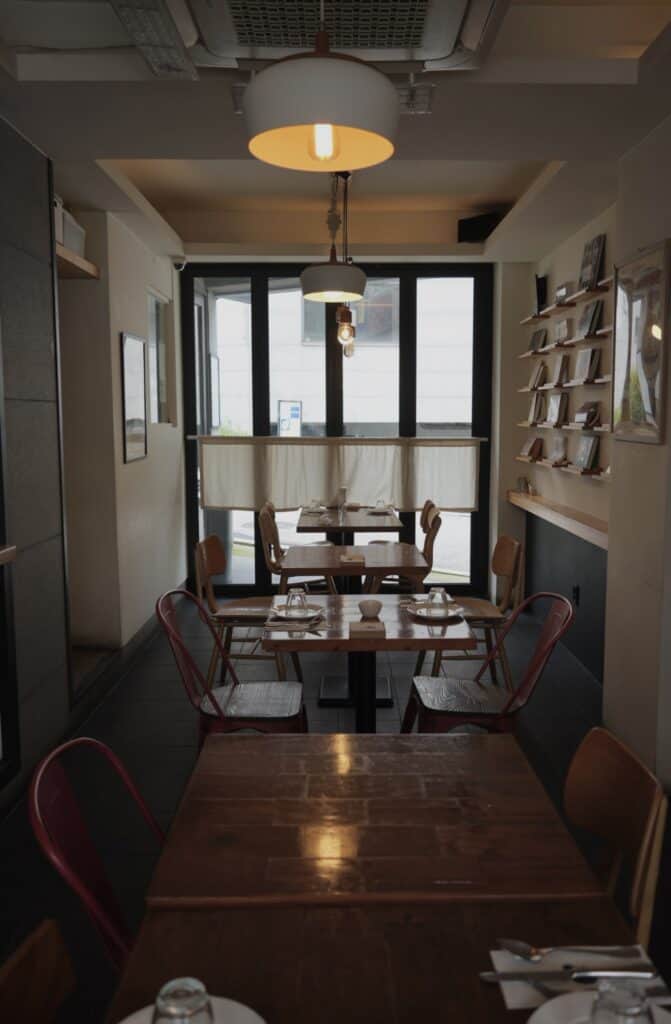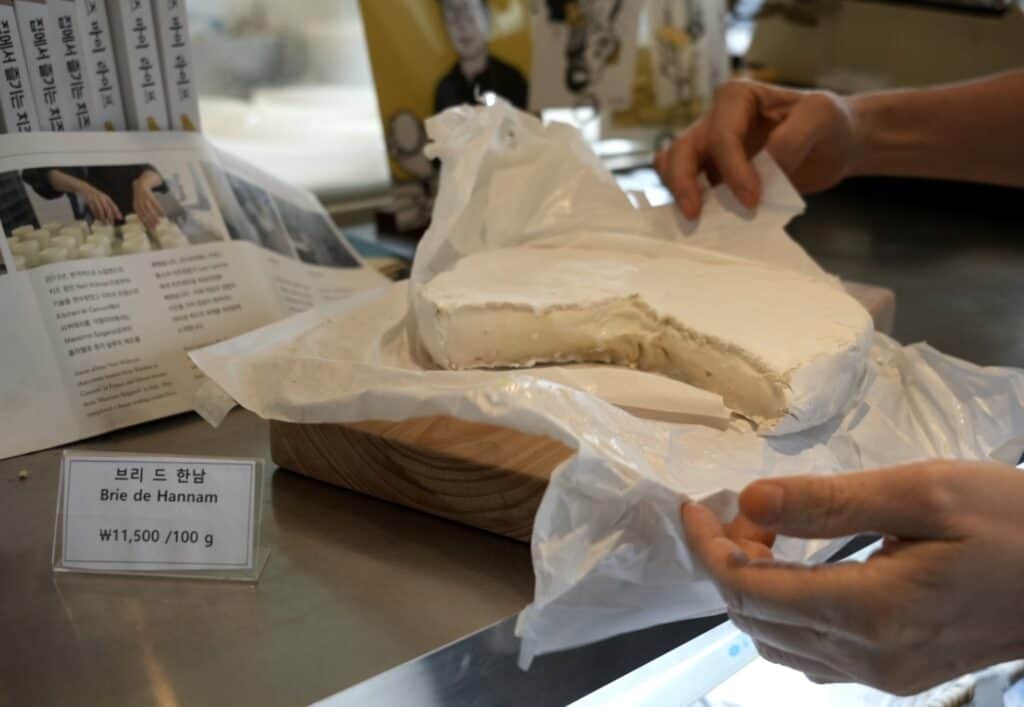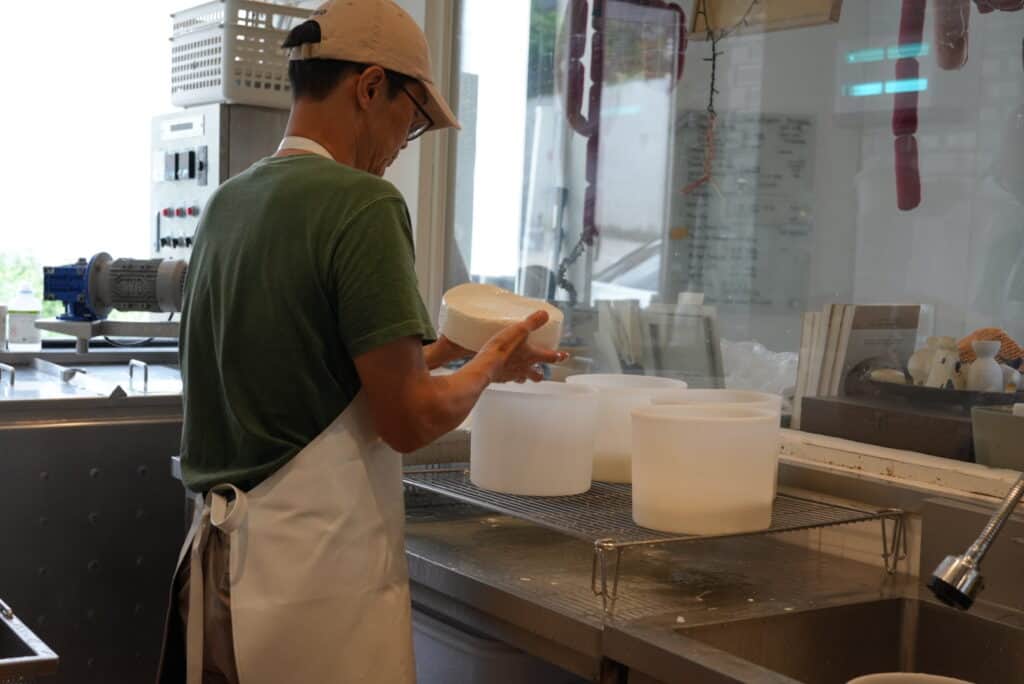

A large deli case greets you when you open the door to Cheese Flo. Fromage blanc, stracchino, feta, Brillat-Savarin, halloumi, mozzarella, and crottin are scattered under the glass. Some of the cheeses are created in house and are named with geography in mind, for example, the Brie de Hannam is named after the Hannam neighborhood, and Italeggio and Itaewon Blue after Itaewon street. Above the case, hams dangle from the ceiling.
Anthony Cho was busy when I ducked into the restaurant from the sweltering July heat. The 57-year-old cheesemaker was hard at work behind the deli counter in a small, glass-insulated room. His wife offered me a glass of water.
“I’m in the process of reinterpreting lactic cheeses in a Korean way,” Cho explains from behind the glass. “On a washed-rind cheese, I’m using Korean traditional liquor. On a cheese like crottin, I’m using a Gamtae Seaweed coating instead of ash.” Cho is preparing to supply these new cheeses to Evett, a Michelin-starred restaurant in Seoul. Though the head chef is not Korean, he wants to create a fine dining experience using Korean ingredients.
Life Before Cheese
Before his path in food began, Cho was a mechanical engineering and business major at Yonsei University, and began working at Samsung after graduating. Five years later, in 1997, Korea slid into a financial crisis and the corporate job he landed with consistent salary, insurance, and stability was on shaky ground.
“I want to quit my job and become a chef,” he recalls exclaiming to his family.
Anthony’s words were assertive despite the worried expression of his free-spirited wife, Haesun. “Let’s move to London,” he followed up. “It will be great for our son and daughter to learn English. I’m in my mid-thirties, and I don’t think I can wait any longer to start something new. There is no promise that I will stay employed. I need to find my own edge that can withstand an ever-changing world.”
Haesun paused and said “Promise me one thing. Promise me that you won’t look back once we go down this road. Give it everything you have, and I will be right there by your side to support you.”
Following Haesun’s inspiring words, Cho ditched his tailored suit for a chef’s coat. At Le Cordon Bleu, Anthony’s classmates provided little camaraderie. In his memoir Cheese My Life, he recalls an instance when a fellow Korean student, a younger woman, said, “Why is this old man trying to cook? He’s causing such a scene.” Anthony learned to cook surrounded by people who looked, sounded, and acted nothing like him.
“There were things I experienced that I can’t bear to relive,” Cho recalls. His savings lasted him two months after finding a flat for his family and paying 15,000 pounds for tuition. His first job was as a glass collector at a pub in Hammersmith where he worked part-time when he wasn’t attending class. He was paid 4.5 pounds per hour.
Cho landed a second job as a line chef at the three-starred Chez Nico. The restaurant was an hour tube ride from his flat in Ealing Broadway, and combined with his pub job and classes, Cho recalls only getting around 6 hours of sleep each night.
A full academic year, and several restaurant stints later, Cho returned to Korea. Upon his return, he unsuccessfully sought employment in a field dominated by 20-somethings who live in a culturally gerontocratic society. After another year, Cho opened his first restaurant, Kitchen Flo. It was a hit. After two successful years, Cho reinvested his entire earnings to expand the restaurant, but the year was 2008 and the financial crisis drove patrons away from fine dining restaurants to gastropubs and izakayas. In 2010, Cho took out a mortgage on his home and opened the gastropub Chez Flo. Like Kitchen Flo, it too was a hit.
Still, the fleeting trends of the restaurant industry sang a melody that was all too familiar. “Cheese,” he thought, “might not [be so fleeting].” In 2016, Cho opened Cheese Flo and began producing slow foods like hams and cheese—artisan goods that resist mass production and are immovable by the temperamental geist of the food world.

The Early Cheese Years
Cho made his first cheese about ten years ago—a camembert style—after attending the New Zealand Cheese School in Putaruru, New Zealand. During those early years of experimentation, he would drive to a dairy farm on Sunday mornings to buy enough milk to make cheese for the week. He recalls wasting hundreds of liters of milk that formed into “protein balls” instead of quality cheese. When he finally made his first successful cheese, he leaned back into his chair and smoked a cigarette like Vito Corleone.
Since then, Cho has attended Academie Opus Caesar’s in France and Antica Corte Pallavicina in Italy to continue studying cheese and salumi making.
While Cho does not refer to Cheese Flo as a family business, his family members have certainly contributed extensively. Haesun, Cho’s wife, works full time managing Cheese Flo’s instagram, website, blog and YouTube, while Cho’s daughter, a graphic designer, helped design the Cheese Flo logo. Cho admits it would be nice if the whole family could work together, but he’s also happy his children (his son is an architect) have opted for more conventional careers.
Being an artisanal cheesemaker in Korea, however, is no easy task. Cho has long wrestled with tactful ways to preserve his craft, a necessity in a country whose policy makers remain comfortable with food systems that are optimized for large food corporations, and a public obsessed with imported products. For cheesemakers, there is a need to create brand awareness for yourself, your foods, your methods, and, most importantly, your drive.

Today and Beyond
Artisans often prioritize craft over sales. While venues like Seoul’s newest farmer’s market Marche offer opportunities for artisans to sell their products, Cho believes there is still room for growth. He and Heasun plan to include cheeses from small cheese producers from around Korea in their annual holiday cheese gift box to raise awareness about local artisans. “Each region of the Korean peninsula is unique, and [so are] their respective specialty foods,” Cho said. “We must begin preserving these cultural gems so they can last and grow over generations to come.”
Cho’s dream is to open his own creamery. He envisions massive underground caves where he can age his cheese with arches made of old stone, such as those in Emilia Romagna. He wants his future property to have a vegetable garden and a vineyard, which will supply his in-house Michelin-starred restaurant. Perhaps during the day, a historian or anthropologist will host tours informing visitors about the history of the land and cultural traditions.
“There’s no quick profit—only an incredibly uncertain future, for us artisans. If you have a family, it’s an even harder task. For someone to live a life dedicated to a single field requires enormous discipline. Money helps but doesn’t create artisanal food,” Cho says. “Sacrifice, dedication, and real strength in the face of incredible hardships—that is what it means to be an artisan.”



